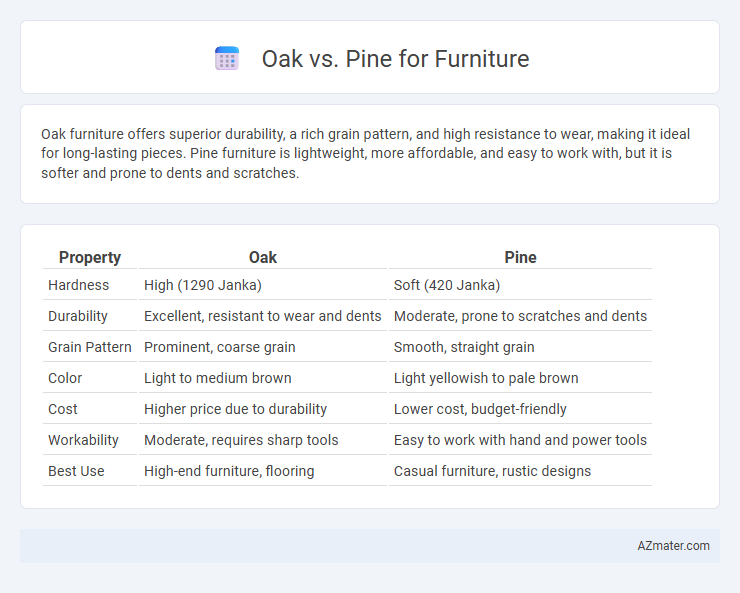Oak furniture offers superior durability, a rich grain pattern, and high resistance to wear, making it ideal for long-lasting pieces. Pine furniture is lightweight, more affordable, and easy to work with, but it is softer and prone to dents and scratches.
Table of Comparison
| Property | Oak | Pine |
|---|---|---|
| Hardness | High (1290 Janka) | Soft (420 Janka) |
| Durability | Excellent, resistant to wear and dents | Moderate, prone to scratches and dents |
| Grain Pattern | Prominent, coarse grain | Smooth, straight grain |
| Color | Light to medium brown | Light yellowish to pale brown |
| Cost | Higher price due to durability | Lower cost, budget-friendly |
| Workability | Moderate, requires sharp tools | Easy to work with hand and power tools |
| Best Use | High-end furniture, flooring | Casual furniture, rustic designs |
Introduction: Oak vs Pine Furniture
Oak furniture boasts exceptional durability and a rich grain pattern, making it a premium choice for long-lasting, elegant pieces. Pine furniture offers affordability and a lighter, softer texture, ideal for casual or rustic designs. Both woods vary in hardness and maintenance, influencing their suitability for different furniture styles and environments.
Wood Characteristics: Oak and Pine Compared
Oak wood features a dense, hardwood structure with a tight grain pattern, making it highly durable and resistant to dents and scratches, ideal for long-lasting furniture. Pine, a softer wood with a lighter weight and prominent knots, offers easier workability and a rustic aesthetic but is more prone to dents and wear over time. The natural hardness of oak provides superior stability and longevity, while pine's softness allows for greater customization and affordability in furniture design.
Strength and Durability Differences
Oak furniture offers superior strength and durability due to its dense grain and hardness, making it highly resistant to dents and scratches. Pine, while more affordable and easier to work with, is softer and prone to dents, scratches, and wear over time. Oak's longevity and ability to withstand heavy use make it ideal for long-lasting furniture, whereas pine suits lightweight or decorative pieces with less frequent use.
Aesthetic Appeal and Grain Patterns
Oak furniture showcases a rich, pronounced grain pattern with distinctive swirls and rays, offering a bold and classic aesthetic appeal that enhances traditional and rustic interiors. Pine features a softer, more uniform grain with occasional knots, creating a warm, casual look that works well in country or cottage-style furniture. The hardwood density of oak provides a smoother finish that highlights its intricate grain details, while pine's lighter tone and texture allow for versatile staining and painting options.
Cost Comparison: Oak versus Pine
Oak furniture is generally more expensive than pine due to its density, durability, and longer lifespan. Pine is a budget-friendly option, offering affordability and easier workability but tends to be less resistant to dents and scratches. Choosing between oak and pine depends on balancing upfront costs with long-term value and maintenance needs.
Workability and Crafting Considerations
Oak offers excellent workability due to its dense grain and strength, making it ideal for durable furniture that withstands heavy use. Pine is softer and easier to craft with basic tools, allowing intricate detailing but may dent or scratch more easily. Craftsmen often choose oak for long-lasting, sturdy pieces and pine for lightweight, budget-friendly projects with simpler construction.
Maintenance and Longevity
Oak furniture offers superior durability and requires minimal maintenance due to its dense grain and natural resistance to wear, making it ideal for long-term use. Pine, while more affordable and easier to work with, is softer and more prone to scratches and dents, necessitating regular sealing or staining to protect its surface. For longevity, oak outperforms pine by maintaining its structural integrity and aesthetic appeal over decades with proper care.
Environmental Impact and Sustainability
Oak furniture often has a higher environmental impact than pine due to longer growth cycles and slower regeneration rates, making oak less sustainable in large-scale production. Pine trees grow quickly and absorb more carbon dioxide during their shorter life span, contributing to better carbon sequestration and faster forest recovery. Choosing pine furniture supports sustainable forestry practices and reduces deforestation pressure compared to the more resource-intensive oak harvesting.
Popular Uses in Furniture Design
Oak is prized in furniture design for its durability, rich grain patterns, and resistance to wear, making it ideal for high-traffic pieces like dining tables, cabinets, and flooring. Pine, with its softer texture and lighter color, is commonly used in rustic or country-style furniture such as beds, shelves, and decorative accent pieces. Both woods offer unique aesthetic and functional qualities that cater to different design preferences and structural needs in furniture making.
Choosing the Right Wood: Oak or Pine?
Oak offers exceptional durability and a dense grain structure, making it ideal for furniture that requires long-lasting strength and a classic aesthetic. Pine features a lighter weight and softer texture, allowing for easier customization and a rustic, casual look suitable for budget-friendly pieces. Selecting between oak and pine depends on factors like desired hardness, grain appearance, maintenance needs, and overall style preferences in furniture design.

Infographic: Oak vs Pine for Furniture
 azmater.com
azmater.com